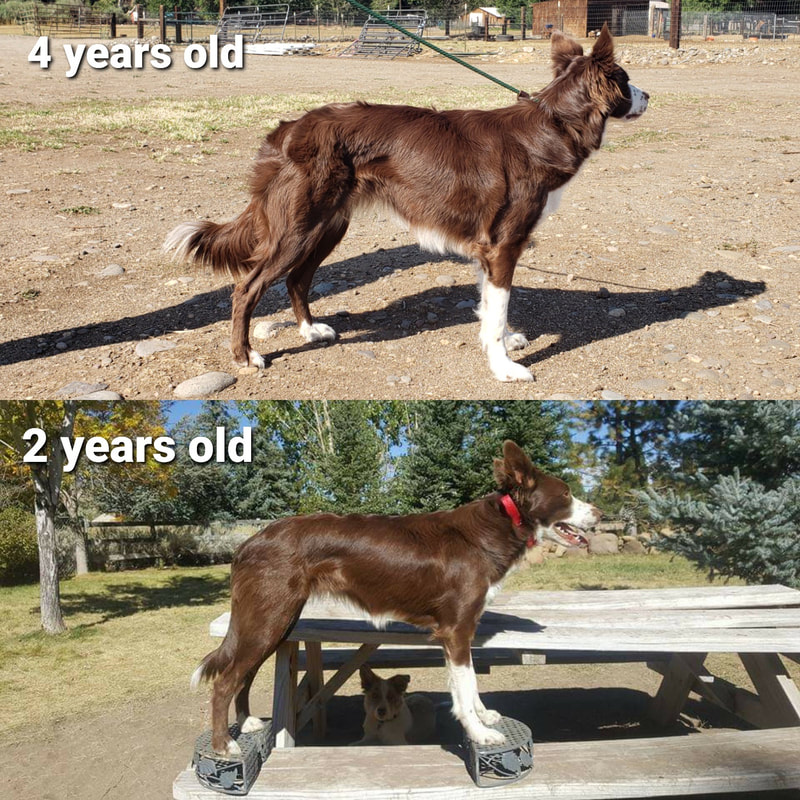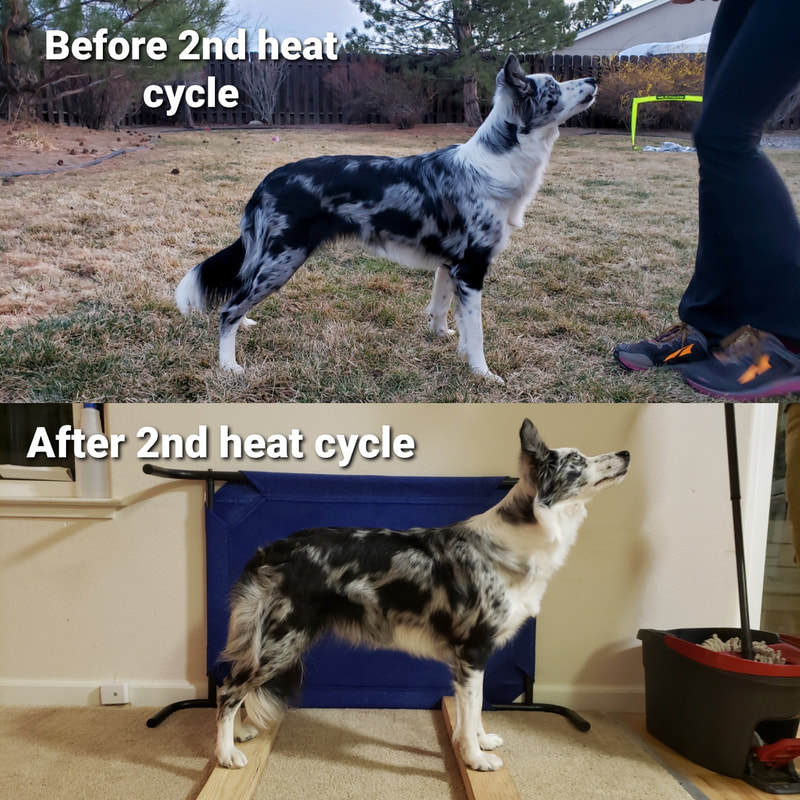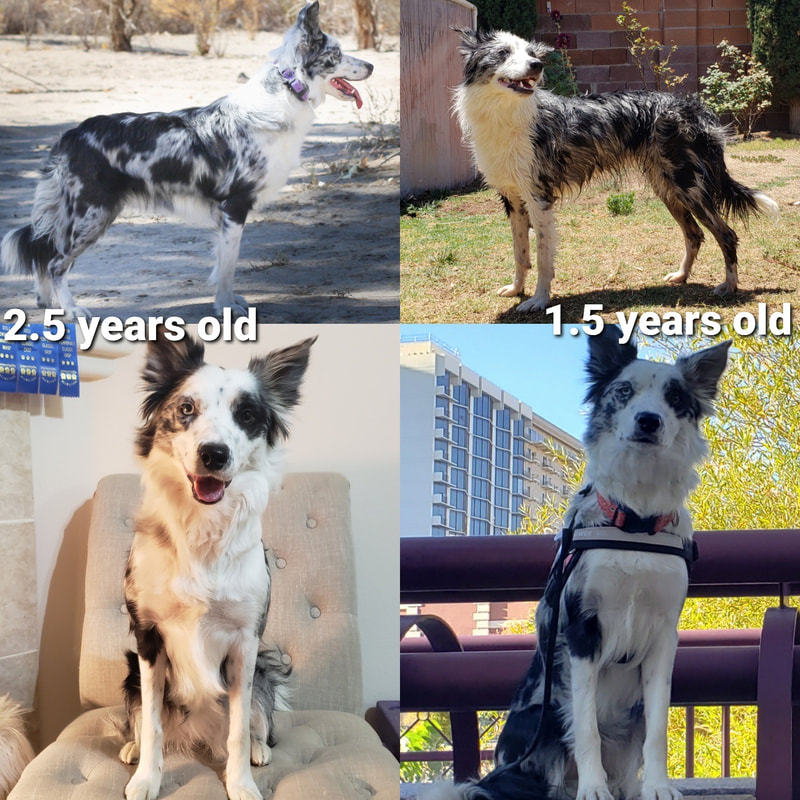|
I’ve been asked several times to talk about the differences between drive and arousal so I wanted to do a quick post! I’ll likely expand on this topic later too.
Arousal is an emotional response to something a dog finds stimulating but doesn’t know why or what it should do with those emotions. Drive is an innate predisposed will to interact directed towards something specific which varies by breed, individual and even what’s been taught. High drive looks like a dog who is willing to work under any conditions or circumstances. A dog that puts the “job” before other things. That can focus on it’s task despite outside stimuli. Even work through discomfort, high pressure, or pain - think police dogs who are being attacked by a human, even stabbed or shot but they still do their job, cattle dogs who get their jaw kicked out of socket and still finish loading that truck, hog dogs who get caught by a tusk and they still don’t let go. Those are a few examples of extremely high drive. Drive also falls into different categories. Prey drive, food drive, toy drive, social drive. Those drives can all vary within an individual as well. A dog with high drive is a dog who keeps coming back to the task at hand with just as much gusto each time even if it didn’t “go well” previously, especially if a reward history is strong. Arousal looks like a dog who is very stimulated by outside influences, easily aroused by things, a hairpin trigger so to speak. Often they are loud/vocal especially in Border Collies, they often have their hackles raised at a moments notice, they have a frantic vibe about them when stimulated rather than a collected intensity. Prone to reactivity of either a friendly or aggressive nature, sensitivity, things like shadow/light chasing, they are often over threshold before much of anything even really happens, which can lead to volatility in some circumstances especially when poorly handled. Arousal can be fun too, it’s a dog who is really interested in what you’re doing and presenting, often a dog who is quite engaged when in drive, it can be funny and cute and playful. A dog can be both high arousal and high drive but that’s not always the case; you can have dogs who are high arousal and easily stimulated by the environment but aren’t particularly driven for any certain thing, and you can have very stable dogs who aren’t easily aroused but are high drive and carry a strong will to do or interact with particular things. Most dogs are a combination of both these things with differing levels and intensities. I’ve gained this knowledge through experience over many years with intimately learning the behavior of hundreds of dogs, and it can be difficult for those with less experience to identify subtle differences, particularly if you don’t have other references to compare to. You could ask 50 different people and get 50 different answers but this is my opinion and experience. But if you’re wondering where your dog falls into this spectrum and would like help evaluating, I am more than happy to assist! Happy to expand more if you have any questions, leave them in the comments!
0 Comments
I want to speak a little on gatekeeping in dogs and why it's problematic.
I'm going to focus on Border Collies but this is relevant to many breeds so feel free to fill in the blanks, so to speak. Border Collies are extremely trendy right now. They have been increasing in popularity over the last decade and it's only going up. People see them in the media, they're so beautiful, so photogenic, they look so great in the hands of a trainer, they do all the things! It's valid why they're popular. They're awesome in so many ways! I get new applications for pups every single day and (while it may take a while for me to respond) it doesn't matter if they are good fits for my program or not, I always give people kindness and support. Even if they won't be getting a dog from me. I have friends who have reached out to many different breeders who have been in the breed a long time and have great lines, really nice dogs. But these breeders are straight up condescending. If you haven't been in the breed and been open field trialing for x amount of years, then you had better not even ask, because there's a good chance you'll be belittled. I can understand why these breeders are hesitant, because Border Collies are experiencing the "Dalmatian affect", everyone wants one & at least half of them want to breed. It's problematic. There's no denying that. However. That gives no excuse to be rude, hostile & disrespectful. How about instead, take the time to kindly educate rather than ostracize? Callousness towards newcomers WILL NOT stop what is happening to the breed. Although it will ensure that all of these newcomers will instead get dogs from unscrupulous breeders & shifty lines, further perpetuating the problem. It results in people having to start from ground zero trying to create good dogs, with little to no guidance. I'm a newer breeder myself, I'm not perfect and neither are my dogs. So I'm not making this post from a position of a gatekeeper but more from the side of the gatekept, because I do wonder sometimes where I'd be today if I had been welcomed instead of disregarded. When you gatekeep the good genetics, you don't stop people from breeding. You stop them from breeding well. I have always been against early spay and neuter. But the more research I do and the more dogs I experience who are allowed to grow to their full potential without altering, the more I question how to judge when a dog is fully finished developing, due to the fact that it varies greatly between breeds, certain lines, and individuals. I understand there are risks associated with keeping intact dogs.
The most obvious of these being unplanned pregnancies but spay and neuter also: • Eliminates the small risk (probably <1%) of dying from testicular cancer • Reduces the risk of non-cancerous prostate disorders • Reduces the risk of perianal fistulas • Reduces the risk of mammary tumors, the most common malignant tumors in female dogs • Nearly eliminates the risk of pyometra, which otherwise would affect about 23% of intact female dogs; pyometra kills about 1% of intact female dogs • Removes the very small risk (≤0.5%) from uterine, cervical, and ovarian tumors And these are the risks we face associated with spay and neuter, namely early spay and neuter: • Abnormal Bone Growth • Hip Dysplasia • Cranial Cruciate Ligament (CCL) Injuries • Bone Cancers, like osteosarcoma • Cancerous heart tumors • Cancerous spleen tumors • Prostate cancer • Bladder cancer • Urinary incontinence in female dogs • Urethral sphincter incontinence in males • Persistent or recurring urinary tract infections • Increased risk of recessed vulva, vaginal dermatitis, and vaginitis • Hypothyroidism • Diabetes • Obesity • Progressive geriatric cognitive impairment • Adverse reactions to vaccines • Noise phobias • Fearful behavior • Aggression • Undesirable sexual behaviors • Unmanageable coat In my puppy contracts, it used to state that to spay or neuter before 18 months is considered a breach of contract and it voids the health guarantee. But as I've seen more and more of the changes dogs (and dogs in my lines, especially) continue to have in their growth and overall physical and mental development after 2 years old, I have updated that clause to state 24 months minimum age for spay/neuter. And I understand that keeping an intact dog isn't in the cards for everyone! That is completely valid. But I do wish people would at least let their dogs finish growing up before making that decision. It really isn't as difficult as it's sometimes made out to be. You can keep your dog from mating through management and with females, they can only get pregnant for a few days each year. It's not a constant thing! Take the time to learn how to identify the signs of your dog going into heat. And for both males and females, train your dogs! It's a common concern that if you don't neuter your male dog, that they will become aggressive or develop other undesirable behavior issues, but these things are more linked to a lack of training rather than being intact or altered, and altering dogs actually increases the risk of aggressive and fearful behavior. In the below photos, you can see my personal dogs and the changes they have undergone during their development. The massive difference between Abigail at 2 years old vs 4 years old leads me to believe I will continue to see more changes in Calypso over the next few years as well, paired with the fact that her breeder informed me her lines are slow to mature. But even still, you can already see big changes in one years time and even in just one heat cycle. I had a male dog with a phenomenal temperament, excellent dog etiquette, and no physical issues who I neutered and immediately watched become dog selective and develop joint pain. I don't think I'll be altering any more of my personal dogs and if so it will be late in their lives and quite probably Ovary Sparing Spays or Vasectomy. I encourage everyone to do the research and form your own opinion on the subject. Don't just blindly follow what the first vet you meet tells you. There are an ever increasing number of veterinarians who are becoming more "progressive" and forward thinking about spay and neuter, but that's another topic! Health and consequences from surgical alteration; *A discussion on studies finding increased aggression and fear in early altered dogs https://www.psychologytoday.com/us/blog/canine-corner/201702/are-there-behavior-changes-when-dogs-are-spayed-or-neutered *Spay, Neuter And Joint Disease http://www.dogsnaturallymagazine.com/spay-neuter-and-joint-disease/ *Long term effects, which clearly outlines the pros/cons- http://www.naiaonline.org/pdfs/LongTermHealthEffectsOfSpayNeuterInDogs.pdf *Considerations, including increase in fears, sound sensitivity, and aggression- http://www.caninesports.com/uploads/1/5/3/1/15319800/earlyspayconsiderations.pdf *Concerning aggression and fearful dogs- http://www.doglistener.co.uk/neutering/spaying_neutering.shtml *Behavior and physical affects, which shows the correlation between neutering and increased aggression- http://www.atftc.com/health/SNBehaviorBoneDataSnapShot.pdf *Increase in bone cancer- http://cebp.aacrjournals.org/content/11/11/1434.full *Article: https://www.avma.org/News/JAVMANews/Pages/100301g.aspx *Neutering Dogs: Effects on Joint Disorders and Cancers in Golden Retrievers http://www.plosone.org/article/info%3Adoi%2F10.1371%2Fjournal.pone.0055937 *Your Dog Needs To Be Spayed Or Neutered – Right? http://www.dogsnaturallymagazine.com/your-dog-needs-to-be-spayed-or-neutered-right/ *Veterinarian Karen Becker, "Why I've Had a Change of Heart About Neutering Pets" including traditional spay/neuter desexing vs. sterilization http://healthypets.mercola.com/sites/healthypets/archive/2013/09/30/neutering-health-risks.aspx *Effects of ovariohysterectomy on reactivity in German Shepherd dogs http://www.sciencedirect.com/science/article/pii/S109002330500064X *Goldens more at risk than Labs http://www.plosone.org/article/info%3Adoi%2F10.1371%2Fjournal.pone.0102241 The easy to understand version http://www.veterinarypracticenews.com/Sterilization-Effects-Worse-for-Golden-Retrievers-Than-Labs/ *Evaluation of the risk and age of onset of cancer and behavioral disorders in gonadectomized Vizslas http://www.ncbi.nlm.nih.gov/pubmed/24432963 The Vizsla study involved 2,505 dogs, and reported these results: • Dogs neutered or spayed at any age were at significantly increased risk for developing mast cell cancer, lymphoma, all other cancers, all cancers combined, and fear of storms, compared with intact dogs. • Females spayed at 12 months or younger, and both genders neutered or spayed at over 12 months had significantly increased odds of developing hemangiosarcoma, compared with intact dogs. • Dogs of both genders neutered or spayed at 6 months or younger had significantly increased odds of developing a behavioral disorder, including separation anxiety, noise phobia, timidity, excitability, submissive urination, aggression, hyperactivity, and/or fear biting. When it came to thunderstorm phobia, all neutered or spayed Vizslas were at greater risk than intact Vizslas, regardless of age at neutering. • The younger the age at neutering, the earlier the age at diagnosis with mast cell cancer, cancers other than mast cell, hemangiosarcoma, lymphoma, all cancers combined, a behavioral disorder, or fear of storms. • Compared to intact dogs, neutered and spayed dogs had a 3.5 times higher risk of developing mast cell cancer, regardless of what age they were neutered. • Spayed females had nine times higher incidence of hemangiosarcoma compared to intact females, regardless of when spaying was performed, however, no difference in incidence of this type of cancer was found for neutered vs. intact males. • Neutered and spayed dogs had 4.3 times higher incidence of lymphoma (lymphosarcoma), regardless of age at time of neutering. • Neutered and spayed dogs had five times higher incidence of other types of cancer, regardless of age of neutering. Spayed females had 6.5 times higher incidence of all cancers combined compared to intact females, and neutered males had 3.6 times higher incidence than intact males. *Neutering: This Common Procedure Can Boost Cancer and Joint Problems As Much As Five-Fold, specifically Golden Retrievers http://healthypets.mercola.com/sites/healthypets/archive/2014/11/05/neutered-golden-retrievers.aspx *Sterilization Effects Worse for Golden Retrievers Than Labs, time of alteration on role in the onset of joint disorders and cancer http://www.veterinarypracticenews.com/Sterilization-Effects-Worse-for-Golden-Retrievers-Than-Labs/ *OSS (ovary sparing spay) http://healthypets.mercola.com/sites/healthypets/archive/2013/09/23/modified-spay-procedure.aspx >16 minute video link of actual surgery, don't watch if squeamish! http://www.parsemusfoundation.org/ovary-sparing-spay/ *Determining the optimal age for gonadectomy of dogs and cats http://www.parsemusfoundation.org/wp-content/uploads/2012/11/Root2007gonadectomyOptimalAge.pdf http://www.naiaonline.org/pdfs/LongTermHealthEffectsOfSpayNeuterInDogs.pdf http://www.caninesports.com/uploads/1/5/3/1/15319800/spay_neuter_considerations_2013.pdf http://www.whole-dog-journal.com/issues/16_2/features/risks-benefits-spay-neuter-your-dog_20685-1.html?pg=2 http://journals.plos.org/plosone/article?id=10.1371/journal.pone.0055937 http://www.caninesports.com/uploads/1/5/3/1/15319800/vizsla_javma_study.pdf http://www.ncbi.nlm.nih.gov/m/pubmed/11439769/ http://saova.org/articles/Early%20SN%20and%20Behavior.pdf http://journals.plos.org/plosone/article?id=10.1371/journal.pone.0102241 http://www.ncbi.nlm.nih.gov/m/pubmed/22647210/ http://www.naiaonline.org/pdfs/LongTermHealthEffectsOfSpayNeuterInDogs.pdf https://www.ucdavis.edu/news/early-neutering-poses-health-risks-german-shepherd-dogs-study-finds https://www.youtube.com/watch?v=enPCZA1WFKY Http://cebp.aacrjournals.org/content/11/11/1434.full http://www.aaha.org/blog/NewStat/post/2014/07/17/785809/UC-Davis-study-neutering-golden-retrievers-Labradors.aspx http://leemakennels.com/blog/dog-biology/dog-health/desexing-its-bad-for-vizslas-too/ https://www.dogworksfitness.com/single-post/2017/12/28/The-1-and-2-common-injury-factors-for-puppies---and-its-not-just-about-hips-and-elbows |
AuthorThe human behind the dogs. Archives
August 2023
Categories |



 RSS Feed
RSS Feed